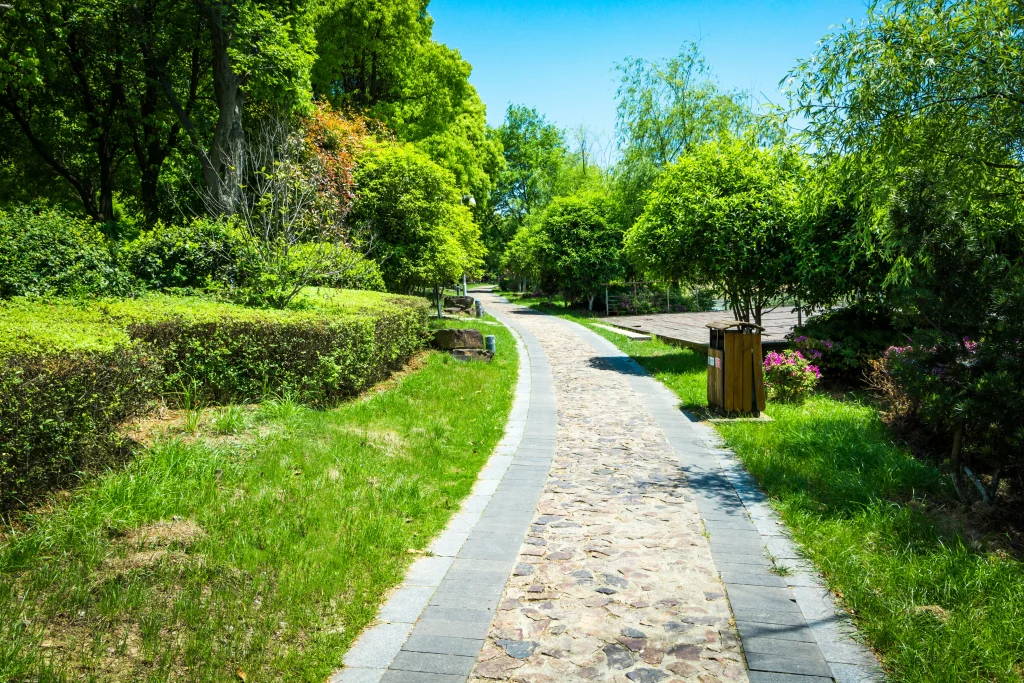Lava rock has emerged as a premier solution for creating beautiful, resilient landscapes that thrive in Colorado’s demanding environment. This volcanic stone offers good durability, water conservation benefits, and fire resistance – critical advantages in our wildfire-prone region.
Unlike traditional mulch that decomposes or blows away in Denver’s notorious winds, lava rock maintains its appearance and function year after year.
We’ll explore 7 proven lava rock landscaping ideas that transform ordinary yards into stunning, low-maintenance outdoor spaces. Each concept addresses Denver’s specific climate challenges while delivering visual impact and long-term value.
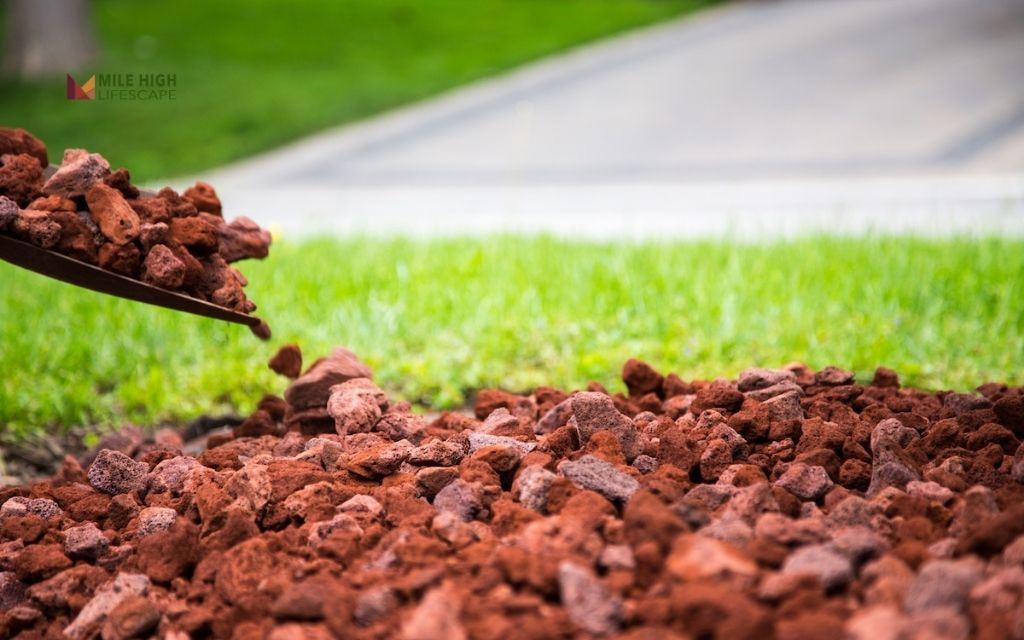
What Is Lava Rock?
Lava rock forms when molten volcanic material cools rapidly, creating a lightweight, porous stone with distinctive texture and color variations. This natural process produces a landscaping material that combines aesthetic appeal with exceptional functionality.
- The stone’s porous structure provides drainage while retaining beneficial soil moisture.
- Its lightweight nature makes installation easier compared to dense alternatives like river rock or granite.
- The irregular surface texture creates visual interest.
3 Types of Lava Rock
Red Lava Rock
Red lava rock brings warm, earthy tones that harmonize with Denver’s natural environment.
This traditional option complements adobe architecture, southwestern design elements, and drought-tolerant plant palettes. The iron oxide content creates rich burgundy to bright red hues that intensify under Colorado’s high-altitude sunlight.
Red varieties work exceptionally well with Colorado native plants like blanket flower, penstemon, and ornamental grasses. The warm tones create cohesive designs when paired with sandstone hardscaping or terra cotta planters.
Many Denver homeowners choose red lava rock for its ability to make green foliage appear more vibrant through color contrast.
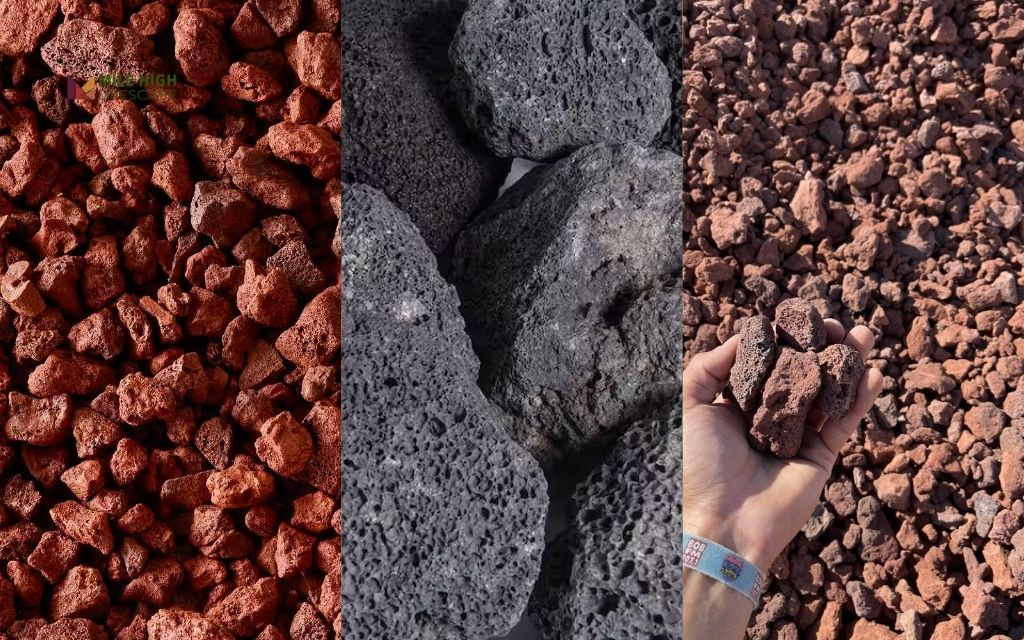
Black Lava Rock
Black lava rock delivers contemporary elegance with bold visual impact. This darker option creates dramatic contrast against light-colored homes, concrete surfaces, and bright plant materials.
Black lava rock landscape ideas often incorporate minimalist design principles. The dark stone provides a striking backdrop for colorful succulents, ornamental grasses, and architectural plants like yucca or agave.
Professional designers frequently use black varieties to create focal points and outdoor living spaces.
Crushed or Nugget Form
Lava rock availability includes various sizes from fine crushed material to large nuggets. Smaller particles work well for pathways and tight spaces around plants. Medium-sized pieces suit general mulching applications and decorative ground cover. Larger nuggets create dramatic accent features and natural-looking drainage solutions.
Size selection impacts both appearance and function. Fine crushed lava rock compacts slightly, making it suitable for walking surfaces. Larger pieces maintain better drainage and resist wind displacement – important considerations for Denver’s weather patterns.
Dive deeper into the other types of landscaping rocks in this guide.
Local Benefits of Lava Rock in Denver Landscapes
Withstands Freeze-Thaw Cycles
Traditional mulches break down rapidly under freeze-thaw stress, requiring frequent replacement. Lava rock’s volcanic origin creates exceptional thermal stability that handles Colorado’s extreme temperature swings without degradation.
The stone’s porous structure allows water to freeze and expand without cracking the material. This characteristic prevents the heaving and shifting common with dense stone options.
Property owners save money and effort by choosing materials that maintain their position and appearance through multiple winter cycles.
Fire-Resistant Protection
Wildfire risk remains a constant concern for Denver-area properties, especially those near foothills and open spaces. Lava rock provides excellent fire resistance compared to organic mulches that can fuel flames and spread fire to structures.
Creating space around homes becomes easier with non-combustible landscaping materials. Insurance companies often recognize fire-resistant landscaping in premium calculations.
Mile High Lifescape recommends lava rock installations within 30 feet of structures for optimal fire protection.
Wind and Weather Durability
Colorado’s winds can reach destructive speeds, particularly during spring and fall transition periods. Light organic mulches blow away, creating maintenance headaches and bare soil exposure. Lava rock’s irregular shape and moderate weight help pieces interlock naturally, resisting wind displacement.
The stone doesn’t decompose like organic alternatives, eliminating the need for annual replacement. This durability translates to long-term cost savings and consistent landscape appearance. Property owners enjoy stable ground cover that looks fresh year after year.
Water-Wise Gardening Support
Water conservation remains critical in Denver’s semi-arid environment.
Lava rock supports xeriscaping principles by reducing soil moisture evaporation while allowing proper drainage. The porous structure helps manage occasional heavy rainfall without creating waterlogged conditions.
Smart irrigation systems work more effectively with lava rock mulching. Water reaches plant roots efficiently while surface evaporation decreases. This combination reduces overall water consumption while maintaining healthy plant growth.
7 Proven Lava Rock Landscaping Ideas for Colorado Success
#1: Native Perennial Garden Borders
Frame your existing garden beds with black lava rock landscaping ideas that highlight Colorado native plants. Create clean, defined edges around penstemon, blanketflower, and blue grama grass plantings.
Apply 2-3 inches of black lava rock around established perennials. The dark background intensifies flower colors while suppressing weeds naturally. This technique works especially well with purple coneflowers and native asters.
Install landscape edging first to contain the rock and prevent migration into lawn areas. Metal or concrete edging provides the cleanest appearance.

#2: Dry Creek Bed Drainage Solutions
Transform drainage areas into attractive landscape features using red lava rock landscaping ideas combined with flagstone accents.
Design meandering pathways that follow natural water flow patterns. Place larger flagstones as stepping points, then fill surrounding areas with medium-grade red lava rock. The contrast creates visual interest while managing stormwater runoff.
The porous lava rock allows water infiltration while directing excess flow away from structures. A dry creek bed is considered one of the best drainage solutions for your yard.
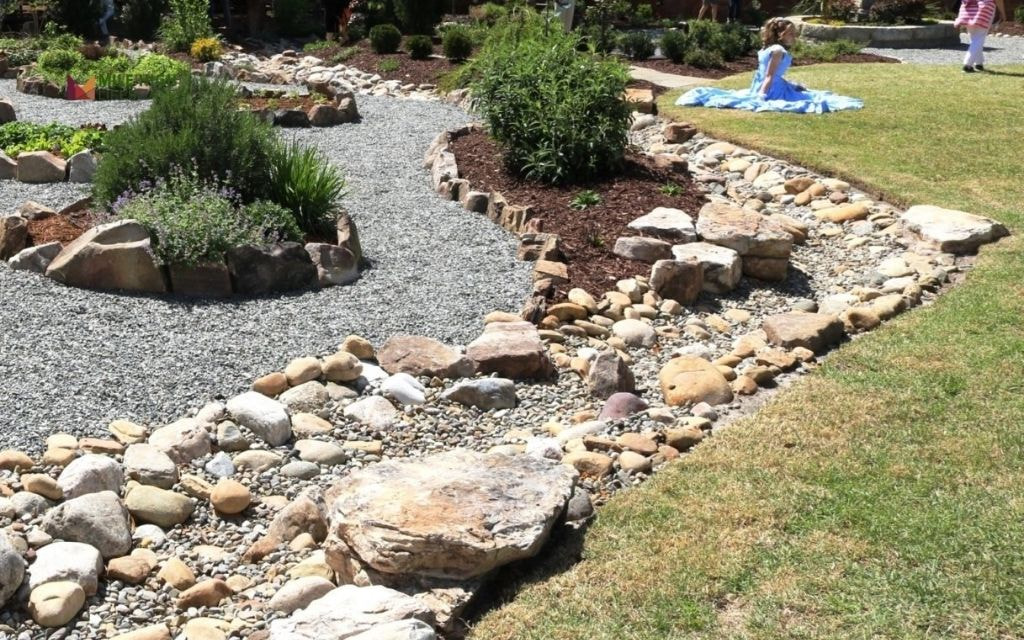
#3: Contemporary Zen Garden Spaces
Create minimalist outdoor retreats using black lava rock as your foundation material. This rock landscaping idea with lava rocks transforms small courtyards or side yards into peaceful gathering spaces.
Level the area and install landscape fabric before spreading 3-inch layers of black lava rock. Add simple outdoor furniture in neutral tones. Incorporate bamboo privacy screening or steel planters for vertical elements.

#4: Fire-Smart Tree Surrounds
Replace flammable bark mulch with red lava rock around mature trees. This landscaping idea with a red lava rock approach protects valuable trees while reducing property fire risk.
Clear existing mulch in a 6-foot radius around tree trunks. Install 2-inch layers of red lava rock, keeping material 3 inches away from bark to prevent moisture retention issues.
This technique proves especially valuable for properties in wildland-urban interface zones like Ken Caryl, Littleton foothills, or areas near Chatfield Reservoir.

#5: Low-Water Succulent Islands
Design eye-catching focal points using black lava rock landscape ideas combined with drought-tolerant plants. Create raised planting areas that require minimal irrigation while providing maximum visual impact.
Group agave, hens and chicks, and ornamental grasses in irregular clusters. Surround plantings with black lava rock, then add boulder accents for scale. The dark rock absorbs heat during the day and releases it slowly, extending growing seasons for cold-sensitive succulents.

#6: Permeable Pathway Solutions
Develop attractive walkways using crushed lava rock between stepping stones or pavers. This application prevents muddy pathways while maintaining natural drainage.
Excavate pathway areas to 4-inch depths, then install geotextile fabric. Add crushed lava rock in 2-inch lifts, compacting lightly between applications. The finished surface remains stable underfoot while allowing water penetration.
This technique works well for connecting deck areas to garden spaces or creating secondary pathways around properties.
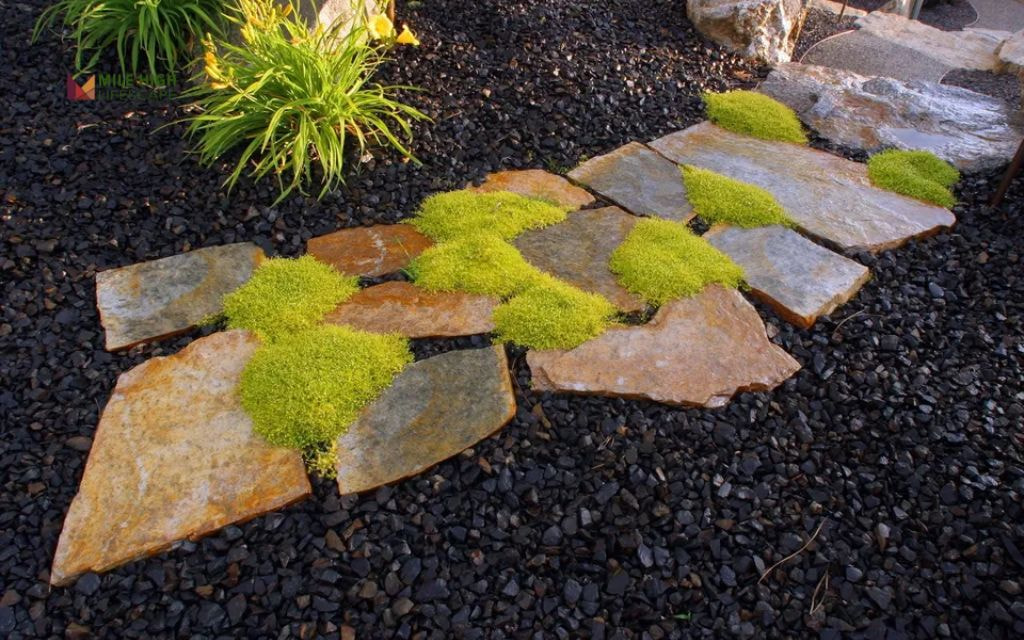
#7: Artistic Focal Point Enhancement
Elevate garden sculptures, water features, or architectural elements using black lava rock landscaping ideas as accent materials. The dark, textured surface creates dramatic backgrounds that highlight focal points.
Clear areas around existing garden art, then apply black lava rock in organic shapes that complement the feature. Vary depth from 1-3 inches to create subtle topography.
This approach transforms ordinary garden ornaments into striking landscape features that command attention year-round.
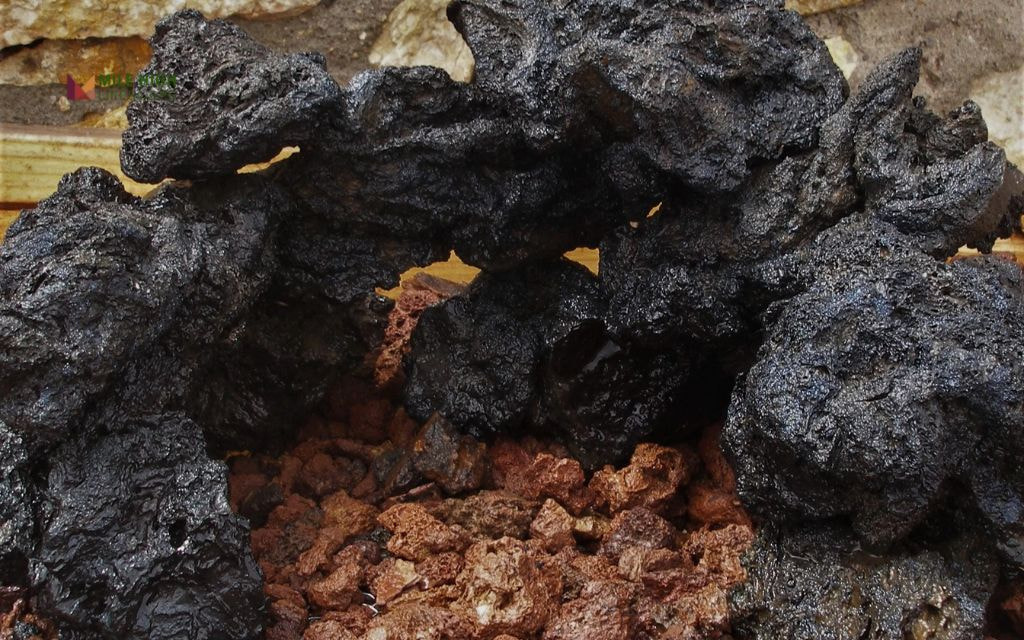
Pro Tips for Using Lava Rock in Denver Yards
- Install landscape fabric first: Lay high-quality weed barrier before placing stone to maximize weed prevention. This foundation prevents soil migration while allowing essential water and air penetration for healthy plant growth.
- Maintain proper depth: Keep lava rock at 2-3 inches deep for most applications. Excessive depth wastes material and hinders plant establishment, while insufficient coverage reduces weed control effectiveness.
- Choose drought-tolerant plant partners: Pair lava rock with plants that thrive in Denver’s climate, such as lavender, blue grama grass, and native yucca species. These combinations create cohesive designs that celebrate Colorado’s high-desert environment.
- Use quality edging materials: Install permanent steel, aluminum, or stone edging to contain rock and maintain clean borders. Quality edging prevents migration into lawn areas and eliminates ongoing maintenance while protecting your landscape investment.
- Rinse before installation: Clean new lava rock with water to remove dust and reveal true colors. This step prevents dusty residue on nearby surfaces and allows proper water infiltration while intensifying the stone’s natural appearance.
- Consider sun exposure: Place black lava rock strategically in areas with intense sun exposure, as darker surfaces absorb more heat. Position away from heat-sensitive plants or incorporate shade elements during peak summer conditions.
- Plan for drainage: Take advantage of lava rock’s excellent drainage properties by using it in areas prone to water accumulation. The porous structure manages Denver’s occasional heavy rainfall while preventing waterlogged soil conditions.
Get more information on how to install landscape rocks for your garden.
Conclusion
Lava rock landscaping ideas represent a smart, stylish solution for homeowners throughout the Denver Metro area. The combination of colors, textures, and layout flexibility allows creative expression while addressing Colorado’s unique environmental challenges.
Long-term benefits include reduced water usage, lower maintenance requirements, and increased property values.
When you’re ready to explore landscaping rocks near me or implement these lava rock landscaping ideas in your Colorado landscape, professional guidance ensures optimal results.
Mile High Lifescape brings nearly two decades of experience to your project, designing and delivering durable outdoor solutions that thrive through even toughest seasons. We’ll help you select the right materials, design custom layouts, and install professional-grade solutions that last for decades.
Contact our expert team at (303) 877-9091 or email hello@milehighlifescape.com to discuss how lava rock landscaping can transform your property.
Frequently Asked Questions (FAQs)
Are lava rocks good for landscaping?
Yes, lava rocks excel in landscaping applications. They provide moisture retention, and create low-maintenance designs. Their natural durability and aesthetic appeal make them ideal for various landscaping projects, especially in arid climates like Denver’s.
Does black lava rock get too hot in the sun?
Yes. Black lava rock absorbs significant heat in direct sunlight. Use it sparingly near delicate plants or choose red varieties for full-sun locations. The thermal mass can benefit some plants but may stress others during peak summer temperatures.
What are the disadvantages of lava rock?
The porous nature allows weeds to sprout through gaps without proper underlayment. Regular maintenance keeps areas looking clean and weed-free. Initial costs exceed organic mulches, though long-term value proves superior.
How to make lava rock look better?
Rinse new installations thoroughly to remove dust and reveal natural color intensity. For existing installations, pressure washing restores original appearance. Regular debris removal maintains clean, attractive surfaces.
What happens if lava rocks get wet?
Lava rock absorbs water readily due to its porous structure. This characteristic benefits most landscaping applications by improving drainage and moisture retention for plants. Avoid using wet lava rock in fire features where rapid heating could cause damage.
